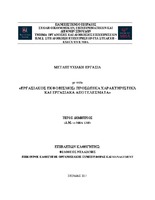Εργασιακός εκφοβισμός: προσωπικά χαρακτηριστικά και εργασιακά αποτελέσματα

Προβολή/
Λέξεις κλειδιά
Εκφοβισμός ; Εργασιακός χώρος ; Δημογραφικά χαρακτηριστικά ; Bullying ; Workplace ; Victimization ; Demographic characteristicsΠερίληψη
Σκοπός: Η αυξανόμενη έρευνα στον τομέα της εργασιακής παρενόχλησης, καθώς και στον
τομέα του εκφοβισμού, επισημαίνει τη σημασία και τη βαρύτητα του θέματος της παρούσας
μελέτης. Φαινόμενα τα οποία δεν αναγνωρίζονται σπανίως μελετώνται. Προς το παρόν, ο
εκφοβισμός και η παρενόχληση στο χώρο εργασίας είναι σε μεγάλο βαθμό ένα «ταμπού», και
σπάνια μελετάται, τουλάχιστον εκτός της Σκανδιναβίας. Πριν από τα τέλη της δεκαετίας του
1960 και έως τις αρχές της δεκαετίας του 1970, το φαινόμενο του εκφοβισμού, συναντάται
κυρίως σε περιπτώσεις εκφοβισμού μεταξύ των παιδιών (ενδοσχολικός εκφοβισμός), καθώς και
με τη μορφή της σεξουαλικής παρενόχλησης των γυναικών στον εργασιακός τους χώρο. Η
εκτεταμένη έρευνα και τεκμηρίωση σε αυτές τις περιοχές κατά τη διάρκεια των τελευταίων
δεκαετιών, έχει δώσει την αρμόζουσα αναγνώριση και προσοχή στο εν λόγω φαινόμενο καθώς
και στην έκταση και σημαντικότητά του ως κοινωνικό πρόβλημα. Σκοπός αυτής της μελέτης
είναι να μελετήσει το φαινόμενο του εκφοβισμού στον χώρο εργασίας, καθώς επίσης και τη
σχέση του με την προσωπικότητα, την ηλικία, την εργασιακή εμπειρία αλλά και το φύλο.
Σχεδιασμός / μεθοδολογία / προσέγγιση: Για την ανάγκη της συγκεκριμένης μελέτης
χρησιμοποιήθηκε ένα ερωτηματολόγιο από τα πιο συχνά χρησιμοποιούμενα γύρω από το
φαινόμενο του εκφοβισμού στον χώρο εργασίας. Η μέθοδος που ακολουθήθηκε ήταν η απλή
τυχαία επιλογή του δείγματος και ακολούθησε στατιστική ανάλυση των πληροφοριών που
συλλέχθηκαν από αυτήν τη διαδικασία.
Ευρήματα: Η στατιστική ανάλυση των δεδομένων έδειξε ότι υπάρχει συσχέτιση του
φαινομένου του εκφοβισμού στον χώρο εργασίας με την προσωπικότητα, το φύλο, τα έτη
εργασιακής εμπειρίας αλλά όχι με την ηλικία.
Πρωτοτυπία / αξία: Στην ελληνική βιβλιογραφία οι μελέτες του φαινομένου μέσω της χρήσης
ποιοτικών δεδομένων είναι έως τώρα ελάχιστες. Μια μελέτη αυτού του φαινομένου έχει την
δυνατότητα να δώσει ένα σημαντικό εργαλείο στα χέρια κάθε οργανισμού ώστε να αποφύγει την
εμφάνιση του φαινομένου στους κόλπους του.


